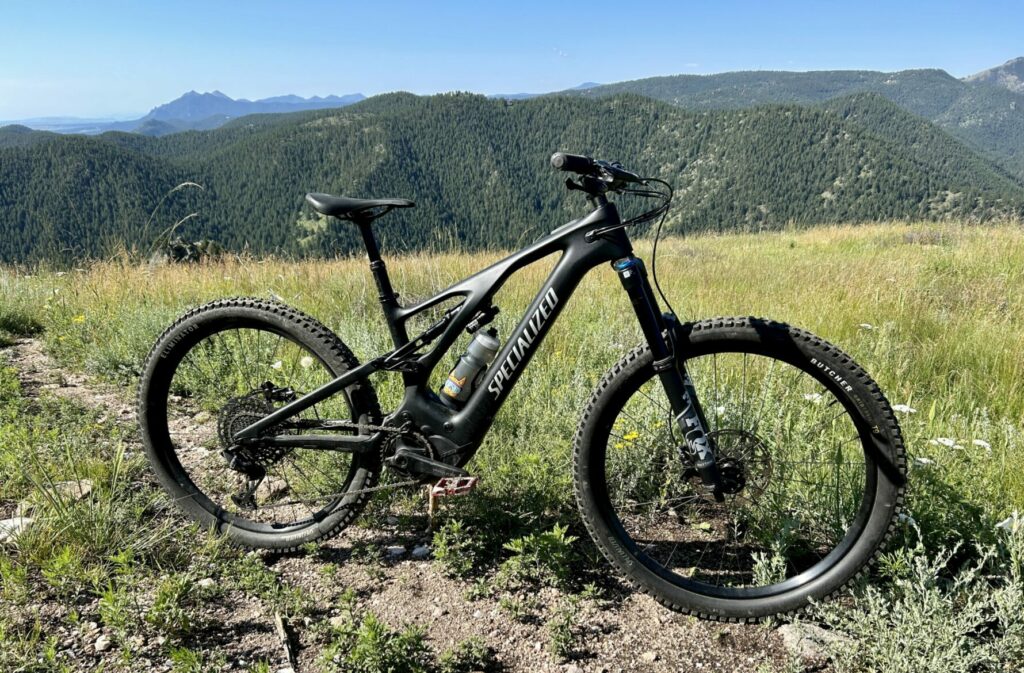Stoke is high, people. I got my hands on a long-term test bike from the folks at Specialized. It’s a Turbo Levo Comp Carbon. Tons of story ideas are swirling around my head right now, but most of them require some extended seat time before I can really unpack the ideas in a comprehensive way.
So to keep you sated in the near term, and to channel my energy for a new toy, here’s a quick look at what I did to set up this full-power e-bike right out of the box.
Specialized Turbo Motor Set-Up
As is typical with Specialized drive units, this bike’s Turbo Full Power 2.2 drive unit has three modes: Eco, Trail, and Turbo. You can tune these modes with the Mission Control app. The two main parameters I adjusted right were Support and Peak Power.
Support is a measure of how much motor assist is delivered in proportion to your pedaling output. Peak Power is the maximum available power the motor can deliver.
Initially, this bike had the Eco mode set at 35/35% (Support/Peak Power), Trail was 35/100%, and Turbo was 100/100%
The Turbo setting makes complete sense, so I didn’t mess with it. However, the Trail mode seemed too sluggish. Maybe this set up would be handy for flatter trails where you get the bike up to near its maximum assist speed (20mph), but for the steep climbing in my area, I didn’t find myself using Trail that often. So, I upped the Support setting to 50% and found it to be a much more versatile mode for moderate climbs and flatter descents.
I also changed Eco to 50% Peak Power. Like the initial Trail mode settings, Eco was initially too underpowered to be useful. With the 35/50% setting, I found it was great for downhills or smooth, gradual road climbs (i.e., My commute home from the trails).
Counterintuitively, by increasing the drive unit’s output in both Eco and Trail modes, I think I managed to improve my battery life. That’s because I ended up using Turbo less, as these updated modes were more useful.
To Do: This bike’s drive unit has a few other intriguing settings that I’d like to play with. The first is Acceleration Response, which adjusts how quickly the motor delivers power. Second is Shuttle Mode, which delivers more e-assist at high cadence.


Specialized Mastermind TCU Set-Up
As I mentioned in my comparison between the Levo SL and Kenevo SL, I love how much information is displayed on the Mastermind TCU. You can customize the different displays, and of course I did. And, of course, you do that customization with the Mission Control app.
One simple thing I changed immediately was to enable audible beeps when pressing any of the handlebar control buttons. I don’t love beeping stuff on a mountain bike, but it makes it easier to be sure that you switched into Turbo mode before a really steep little technical climb, for example.
I settled on three key TCU displays. The first is a simple time and distance combo. The second shows battery life, rider power, and motor power. Maybe I’m the only nerd who thinks about this, let alone cares about this, but I like to see power output, and it’s interesting to watch how the motor output responds as you ride. Initially, I had time of day on this display, but I prefer to always have a battery read-out. Time is just a human construct, anyway.
The third display is all about battery health: Estimated range, battery %, and a widget that shows if battery consumption is increasing, decreasing, or remaining the same. Given how variable my terrain is, I’m not sure how useful the estimated range is for me. It can change drastically based on just one steep climb in Turbo.
Also of note, I easily paired a Bluetooth heart rate monitor to the TCU. Why am I measuring heart rate, you might wonder … Stay tuned.
Finally, I was pleased to see how cleanly the Mission Control app integrated with Strava, uploading all of my ride data, including power.
Turbo Levo MTB Component Set-Up
Last but not least, I went through the usual procedures to get the Fox suspension dialed on this Levo. The 36 Rhythm fork and Float X Performance shock aren’t flashy or gold, but they really do the job without too much fiddling. Stock settings were fine for me, compensating for the e-bike’s weight, naturally.
To Dos: I’d like to try lowering the handlebars to improve how this bike climbs on steep stuff. I’ve always had a weird proclivity toward steep, technical climbs, and the e-MTB really scratches that itch. However, the front end is pretty tall and tends to wander. I also need to put in some tire inserts, likely CushCore, as soon as possible. This bike is quite a smash wagon. Finally, I might fiddle with the flip chips that adjust the bike’s geometry. However, I don’t want the front end to be drastically more slack. Overall, it’s remarkable how good this bike rides bone-stock with factory settings.
Coming Up
Here are some story ideas that I’m toying with. Let me know if you like ‘em, or if you have requests or suggestions:
- Deep dive on using the Mission Control app
- Turbo tuning day to get the drive unit’s modes exactly the way I want them.
- Smart Control: What happens when I let the bike decide how to use the battery?
- And of course, the garden-variety long term review.
Thanks for reading!
P.S. We use affiliate links here at Direct Current. If you’re considering buying a Specialized Turbo Levo Comp Carbon, we’ll get a little kickback if you purchase using a link from this story. 😀

2 thoughts on “Initial Set-Up: Specialized Turbo Levo”
Good read. This is really helpful, thanks Spencer. Looking forward to doing laps at OHV!
Thanks Neal! Let’s get out there!